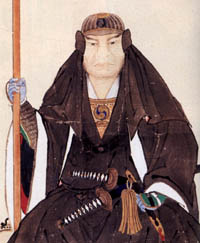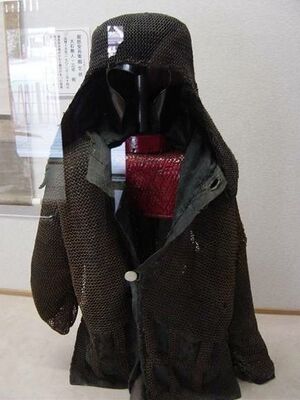Oishi Kuranosuke
- Birth: 1659
- Death: 1703
- Titles: Akô han Karô
- Japanese: 大石 内蔵助 良雄 (Ooishi Kuranosuke Yoshitaka/Yoshio)
Biography
In the episode of "the 47 Ronin", Ôishi Kuranosuke Yoshio on the whole appears to come off looking much better than his lord Asano Naganori from a purely historical standpoint. As Asano left the governing of his province to his vassals, Ôishi as his chief retainer must get the credit for running the province in an effective and relatively smooth manner. Ôishi seemed to be an intelligent man and a good judge of human nature-his management of the Akô ronin, 46 (actually more, but several dropped out over the course of the plan) other men with varying motivations and degrees of commitment (there is a report prepared by Ôishi examined by scholar Henry Smith that rates the degree of commitment each of the plotters had in his estimation, one more piece of evidence that the men involved were not all acting out of loyalty to a failed lord), showed a shrewd ability to plot and implement a plan that required juggling many variables.
Ôishi's much celebrated act of being a drunken womanizer after becoming a ronin appears to have largely fiction, as none of the metsuke reports on his behavior mention him carrying on such a charade. It is possible that since it is documented that Asano’s retainers were promoted and rewarded based on their abilities to procure women and provide entertainment that the legend of this "charade" was based on Ôishi's everyday behavior. This appears to be the case, as established by Andrew Rankin in his book 'Seppuku': “When not plotting murderous revenge, Kuranosuke would head for the pleasure quarters and drown himself in drink. His behavior has been explained as a ruse to throw Kira’s spies off the scent. But Kuranosuke had a reputation as a drinker long before the Ako Incident, and there seems no reason to doubt that he was simply making the most of his last few months on earth”.
Despite these positive qualities, Ôishi must shoulder the burden of having purposely neglected Asano's training and education, leading to a lack of discipline on Asano's part that resulted in the poorly executed attack on Lord Kira Yoshinaka in the Shogun’s castle. Indeed, Ôishi is singled out in the Shogunal report Dokai Koshuki for this failing. It appears Ôishi enjoyed being the "power behind the throne" and was reluctant to prepare Asano in the carrying out of these duties, fearing losing his postion of power and authority. Ôishi was known among Edo officials as Lord 'Hiru-andon' (Lord 'Daytime Paper Lantern', a common nickname for a 'useless person'). As the de facto chieftain of Akô, Ôishi also was the mastermind of a plan to issue devalued currency that was backed by only 60% cash. While Akô was far from the only fief that engaged in such a practice, it demonstrates contempt for the people of Akô and the merchants who were forced to accept this devalued currency, resulting in a loss of 40% to anyone who was stuck with the notes. Returning to Rankin, he writes “Today an untouchable hero, he was not always known for brilliance. As a young administrator he was nicknamed ‘daytime lantern’ (hiru-andon); in other words, he was useless. He was not good with money, and needed assistance from senior retainers when handling anything financial. His first talent seems to have been for heavy drinking”. Finally, Ôishi has to take responsibility for leading a raid that killed both guards and innocent unarmed household staff alike (whose only crime was working for Lord Kira). Despite the fact that Ôishi’s men outnumbered Kira’s sleeping guards by a ratio that is commonly put at 47 to 5 (and by some accounts, 47 to 3), they still felt the need and justification to kill unarmed civilians.
Ôishi Kuranosuke in Fiction
Film
- Gishi Meimei Den Oishi Kuranosuke (義士銘々伝 大石内蔵助) 1910
- Oishi Kuranosuke Ichidaiki (大石蔵之助一代記) 1910
- Oishi Azumakudari(大石東下り) 1912
- Ôishi Kuranosuke Ichidaiki (大石内蔵助一代記) 1913
- Ôishi Kuranosuke Jitsuden (大石内蔵之助実伝) 1919
- Ôishi yamashina no Wakare (大石山科の別れ) 1917
- Akô Gishi Ôishi Saishi no Wakare (赤穂義士 大石妻子の別れ) 1921
- Adauchi Nipponbare (仇討日本晴) 1931
- Ôishi Kuranosuke (大石内蔵之助) 1922
- Aruhino Ôishi(或る日の大石) 1923
- Ôishi Yamaga Goso (大石山鹿護送) 1941
- Chushingura (忠臣蔵) 1958
- Chushingura Shijushichinin no Shikaku (忠臣蔵 四十七人の刺客) 1994
Television
- Ôishi Saigo no Hi(大石最後の一日) 1959 KR
- Akôrohi (赤穂浪士) 1964 NHK
- Adauchi(仇討ち) 1968 TBS
- Toge no Gunzo (峠の群像) 1982 NHK
- Chushingura (忠臣蔵) 1990 TBS
- Ôishi Kuranosuke,Fuyu no Kessen (大石内蔵助・冬の決戦) 1991 NHK
- Chushingura (忠臣蔵) 1991 CX
- Dai Chushingura (大忠臣蔵) 1994 TBS
- Chushingura (忠臣蔵) 1996 CX
- Genroku Ryoran (元禄繚乱) 1999 NHK
- Chushingura (忠臣蔵) 2004 EX
Books
- Ore no Ashioto (おれの足音) Ikenami Shotaro
- Ôishi Kuranosuke (大石内蔵助) Kano Atsushi
- Shosetsu Ôishi Kuranosuke (小説大石内蔵助) Habu Michihide
References
- Bodart-Bailey, Beatrice M The Dog Shogun:The Personality And Politics Of Tokugawa Tsunayoshi Honolulu:University Of Hawai’i Press, 2006
- Kanai Madoka, editor Dokai Koshuki in Edo Shiryo Sosho Tokyo:Jinbutsu Oraisha, 1967
- Tokutomi Ichiro Kinsei Nihon Kokuminshi vols 11-19, Tokyo:Minyusha, 1935-1936
- Sato Naokata Yonjuroku Nin No Hikki� NST, Vol 27
- Bito Masahide The Akô Incident, 1701-1703 in Monumenta Nipponica 58:2 (Summer 2003)
- Rankin, Andrew, Seppuku Tokyo:Kodansha International Ltd, 2011
- Sakata Moroto, unpublished memoirs-Kai Shosho Yoshiyasu Ason Jikki vol 30, Genroku 15, property of University Of Tokyo
- Sato Hiroaki Legends Of The Samurai The Overlook Press, 1995
- Rekishi Dokuhon 2007 Jan

